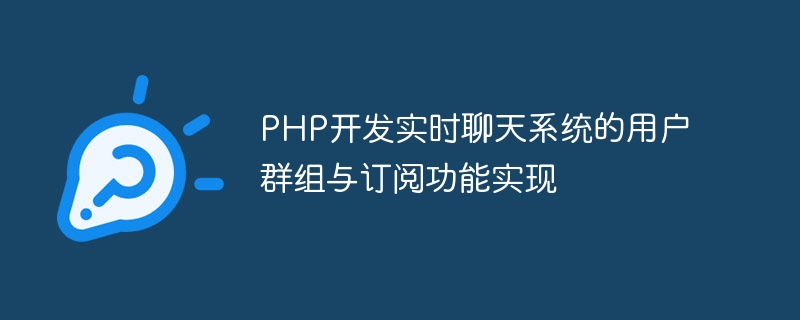

PHP development of user groups and subscription functions of real-time chat system
In today's social Internet era, real-time chat system has become an important tool for people's daily communication. In order to provide a better user experience, we need to implement user group and subscription functions so that users can easily create and join groups, and subscribe to content of interest.
This article will introduce how to use PHP to develop user groups and subscription functions of a real-time chat system. We will use WebSocket to implement real-time communication functions and combine it with a MySQL database to handle user and group information.
First, we need to build a basic real-time chat system framework. The following is a simple WebSocket server example, implemented using the Ratchet library:
require 'vendor/autoload.php';
use RatchetMessageComponentInterface;
use RatchetConnectionInterface;
use RatchetServerIoServer;
use RatchetHttpHttpServer;
use RatchetWebSocketWsServer;
class Chat implements MessageComponentInterface {
protected $clients;
protected $groups;
public function __construct() {
$this->clients = new SplObjectStorage;
$this->groups = array();
}
public function onOpen(ConnectionInterface $conn) {
$this->clients->attach($conn);
echo "New connection: ({$conn->resourceId})
";
}
public function onMessage(ConnectionInterface $from, $msg) {
// 处理收到的消息
}
public function onClose(ConnectionInterface $conn) {
$this->clients->detach($conn);
echo "Connection {$conn->resourceId} has disconnected
";
}
public function onError(ConnectionInterface $conn, Exception $e) {
echo "An error has occurred: {$e->getMessage()}
";
$conn->close();
}
}
$server = IoServer::factory(
new HttpServer(
new WsServer(
new Chat()
)
),
8080
);
$server->run();The above example creates a WebSocket class named Chat to handle the opening, messaging, and closing events of the connection. Among them, $this->clients is a SplObjectStorage object that saves all client connections, and $this->groups is an array that saves group information. .
Next, we need to add some methods to implement the user joining group and subscribing functions. Add the following code to the Chat class:
public function joinGroup(ConnectionInterface $conn, $groupId) {
// 将用户加入群组
$this->groups[$groupId][] = $conn;
echo "User ({$conn->resourceId}) joined group {$groupId}
";
}
public function leaveGroup(ConnectionInterface $conn, $groupId) {
// 将用户从群组中移除
$index = array_search($conn, $this->groups[$groupId]);
if ($index !== false) {
unset($this->groups[$groupId][$index]);
echo "User ({$conn->resourceId}) left group {$groupId}
";
}
}
public function subscribe(ConnectionInterface $conn, $topic) {
// 订阅某个主题
$conn->topics[] = $topic;
echo "User ({$conn->resourceId}) subscribed to {$topic}
";
}
public function unsubscribe(ConnectionInterface $conn, $topic) {
// 取消订阅某个主题
$index = array_search($topic, $conn->topics);
if ($index !== false) {
unset($conn->topics[$index]);
echo "User ({$conn->resourceId}) unsubscribed from {$topic}
";
}
} In the above code, the joinGroup method adds the user to the specified group, and the leaveGroup method moves the user from the group Except, the subscribe method subscribes the user to the specified topic, and the unsubscribe method cancels the user's subscription to a topic. When a user joins a group or subscribes to a topic, we need to save relevant information to the database.
The following is an example database table structure for saving user and group information:
CREATE TABLE `users` ( `id` int(11) UNSIGNED AUTO_INCREMENT PRIMARY KEY, `name` varchar(255) NOT NULL, `email` varchar(255) NOT NULL ); CREATE TABLE `groups` ( `id` int(11) UNSIGNED AUTO_INCREMENT PRIMARY KEY, `name` varchar(255) NOT NULL ); CREATE TABLE `group_user` ( `group_id` int(11) UNSIGNED NOT NULL, `user_id` int(11) UNSIGNED NOT NULL, PRIMARY KEY (`group_id`, `user_id`), FOREIGN KEY (`group_id`) REFERENCES `groups`(`id`), FOREIGN KEY (`user_id`) REFERENCES `users`(`id`) );
When a user joins a group or subscribes to a topic, we can use the following code to insert relevant information In the database, the specific logic can be modified according to actual needs:
public function joinGroup(ConnectionInterface $conn, $groupId) {
// 将用户加入群组
// ...
// 将用户加入数据库
$userId = $_SESSION['user_id']; // 假设用户登录时已经保存用户ID到session中
$query = "INSERT INTO group_user (group_id, user_id) VALUES (?, ?)";
$stmt = $mysqli->prepare($query);
$stmt->bind_param("ii", $groupId, $userId);
$stmt->execute();
}
public function subscribe(ConnectionInterface $conn, $topic) {
// 订阅某个主题
// ...
// 将订阅信息保存到数据库
$userId = $_SESSION['user_id'];
$query = "INSERT INTO subscriptions (user_id, topic) VALUES (?, ?)";
$stmt = $mysqli->prepare($query);
$stmt->bind_param("is", $userId, $topic);
$stmt->execute();
}We can also implement some other functions, such as getting the user's group or subscribed topic from the database, and receiving the received message Sent to relevant connections.
Through the above implementation, we have successfully implemented user groups and subscription functions in the real-time chat system developed in PHP. In this way, users can easily create and join groups, subscribe to content of interest, and get a better communication experience in the real-time chat system.
The above is the detailed content of PHP develops user group and subscription functions of real-time chat system. For more information, please follow other related articles on the PHP Chinese website!